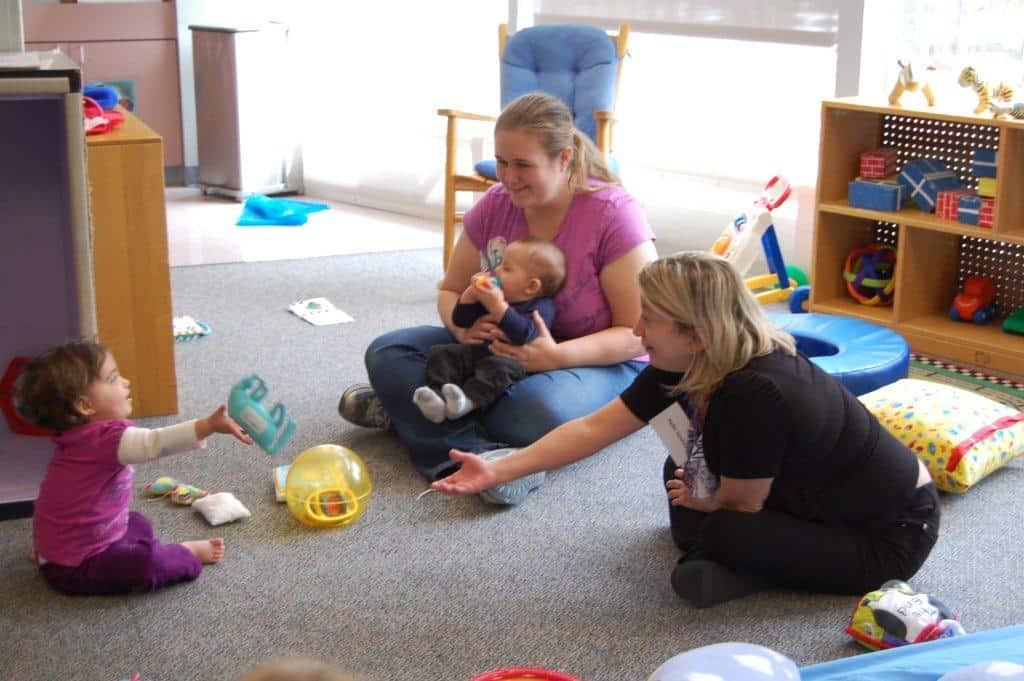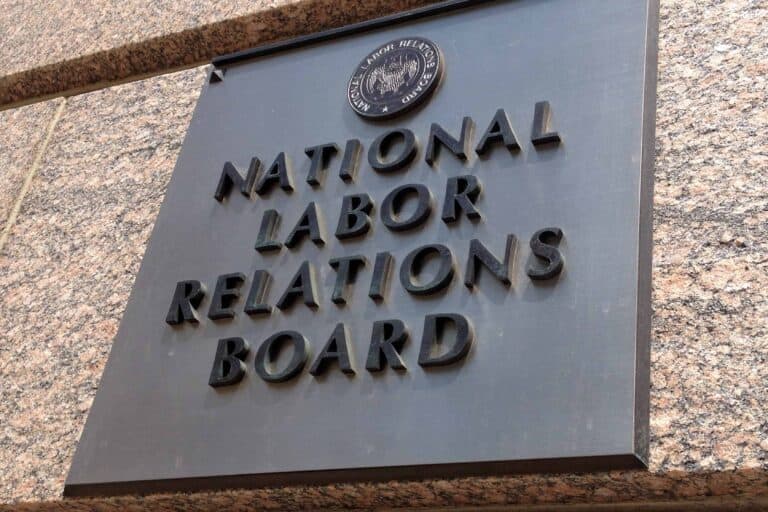
Alex Blutman is a student at Harvard Law School and a member of the Labor and Employment Lab.
Labor activism and organizing has flourished recently, as the pandemic exacerbated fractures in various industries that jumpstarted organizing. The shockwaves were also felt in childcare, where high costs, low wages, and staffing problems worsened, yet the associated organizing surge was more difficult to spot. What does successful organizing look like in childcare now?
Our flawed childcare system affects two groups of workers. First, programs are unaffordable for parents, which hampers their ability to work. The HHS affordability standard for childcare is 7% of a family’s income, yet in Massachusetts, the annual cost of infant care for a minimum wage worker would constitute 78.9% of income. Meanwhile, industry employment has declined more than 10% from pre-pandemic levels, and providers are shuttering, forcing more parents home with their kids. Women disproportionately bear the effect—nearly 1.6 million women are mothers of children under 17 that left the labor force during the pandemic and haven’t returned. Second, childcare providers themselves make little money (median hourly pay is ~$12) with few benefits. For a childless single adult, the median childcare worker wage in only 10 states is equivalent to or more than the living wage in that state. Nationally, childcare workers with children are more than twice as likely to live in poverty as other workers’ families.
Childcare’s economic model explains this paradox (funded primarily by private tuition and budgeting up to 60% for labor costs, providers are sensitive to enrollment dips and operate on exceptionally tight margins), but it doesn’t fully capture the system’s larger forces, which are deeply tied to gender and racial injustices. Long furnished by women’s unpaid labor, childcare remains enormously undervalued, while occupational segregation exacerbates the gender wage gap. Women represent 94% of the workforce, and 40% of that group is non-white. The perception that childcare is not “real” work is rooted in oppression of women of color who have long performed domestic work, yet been excluded legally from employment and labor law’s protections. Naturally, these exclusions have real effects: while 18% of women childcare workers overall live in poverty, that number is 23% for Black women and 22% for Latinas. Meanwhile, lack of access to affordable childcare has differentiated effects across gender and race for working parents. Women continue to bear a disproportionate share of childcare and housework despite representing half the labor force and serving as breadwinners in 42% of families with children, and Hispanic and Black women are even more likely to be sole breadwinners. One-third of childcare centers that closed during the pandemic remain so, most of which served Asian, Latino, and Black families.
Organizing providers to respond to these challenges is not easy. Most childcare workers operate in center-based programs in decentralized system that makes organizing more difficult. At any one center, worker numbers are small and turnover high. Organizing across worksites, while generally disfavored under labor law, is especially onerous given the variety of employers and may not even truly be viable without a system of sectoral bargaining in place. Family childcare (“FCC”) providers, for their part, have had some success organizing under a different model. Without clear employee status, these home-based workers, who are typically regulated and receive income through subsidies provided by the state, have relied on state legislation and executive orders to grant them collective bargaining rights with the state as employer. In 2005, Illinois was first to extend bargaining rights to FCC providers. Today, only 12 states recognize collective bargaining for such workers who, after a 2014 SCOTUS decision, cannot be required to pay union dues.
Turning the tide may begin with further efforts to unionize FCC providers at the state level to build on the positive results achieved in Illinois. California provides a more recent example where, after a 16-year organizing effort, childcare workers voted to join a union following legislation passed in 2019 providing them collective bargaining rights. In June, the union reached an agreement with state negotiators to increase provider reimbursement rates by at least 15%.
Agitating for legislative reforms is key, both for FCC providers who require state authorization to bargain collectively and for center-based providers for which collective bargaining is exceedingly difficult. As law professor Peggie R. Smith, explains, “Strategies for union representation of the childcare workforce must also allow for the fact that many families are simply unable to pay childcare workers decent wages. In light of this reality, childcare unionization may have difficulty garnering public support if the bargaining process undermines parents’ ability to afford childcare or sacrifices the interests of children receiving such care.” Margins in childcare are so thin that wages would inevitably increase costs for parents. While in a typical union negotiation employers may internalize increased costs and/or pass them on to consumers, parents cannot be expected to bear the extra burden here.
A total system overhaul seems necessary, and if international comparisons are any indication, that begins with greater government subsidization. The U.S. currently spends merely 0.2% of G.D.P. on childcare for children 2 and under, compared to an average of 0.7% for comparable wealthy countries. In Denmark, which spends $23,140 annually per child on early adolescent care compared to the U.S.’s $500, children are guaranteed a spot in a childcare facility (most of which are government-run) up to age 10, and parents pay only 25% of the cost. Whether tuition is based on income as in some places in Germany, or tax credits cover up to 85% of the cost of care as in France, parents receive more government assistance in other wealthy countries than they do in the U.S. Biden’s childcare plan, currently tied up in negotiations over the larger spending bill in Congress, would make some headway: decreasing childcare costs for low-earning families, providing universal public preschool, and increasing provider pay. The American Families Plan would, crucially, also expand paid leave and child tax credits, provisions that are inextricable from a comprehensive system of childcare.
As Professor Smith continues, “If labor is to help FCC providers secure improved wages and working conditions, it must push for increased public support and funding for childcare.” This means continuing to fight alongside a broad-based coalition of parents, childcare employers, and community groups in a form of activism that targets goals beyond unionization. There’s ample precedent for that: in Cincinnati, where childcare providers joined forces with city organizers in support of universal pre-K; in Oakland, where advocates won investments in childcare subsidies; in New Mexico, where organizers secured hazard pay for childcare workers during the pandemic; and in Washington, D.C., where community groups not only reversed planned childcare cuts, but also won an additional $5 million in emergency funding for child development centers and $1.4 million for COVID-19 protection measures. Although childcare workers remain largely non-unionized, the union model is at the heart of these achievements. An organizing plan originally implemented for homecare workers that emphasizes grassroots momentum, policy changes, and coalition building is being adapted by and for childcare workers as we speak—here’s to the hope they meet with similar success.










Daily News & Commentary
Start your day with our roundup of the latest labor developments. See all
December 15
NLRB limits employers' unilateral changes; Klarna leans into AI over hiring
December 13
In today’s News & Commentary, the Senate cleared the way for the GOP to take control of the NLRB next year, and the NLRB classifies “Love is Blind” TV contestants as employees. The Senate halted President Biden’s renomination of National Labor Relations Board Chair Lauren McFerran on Wednesday. McFerran’s nomination failed 49-50, with independents Joe […]
December 11
In today’s News and Commentary, Biden’s NLRB pick heads to Senate vote, DOL settles a farmworker lawsuit, and a federal judge blocks Albertsons-Kroger merger. Democrats have moved to expedite re-confirmation proceedings for NLRB Chair Lauren McFerran, which would grant her another five years on the Board. If the Democrats succeed in finding 50 Senate votes […]
December 10
In today’s News and Commentary, advocacy groups lay out demands for Lori Chavez-DeRemer at DOL, a German union leader calls for ending the country’s debt brake, Teamsters give Amazon a deadline to agree to bargaining dates, and graduates of coding bootcamps face a labor market reshaped by the rise of AI. Worker advocacy groups have […]
December 9
Teamsters file charges against Costco; a sanitation contractor is fined child labor law violations, and workers give VW an ultimatum ahead of the latest negotiation attempts
December 8
Massachusetts rideshare drivers prepare to unionize; Starbucks and Nestlé supply chains use child labor, report says.